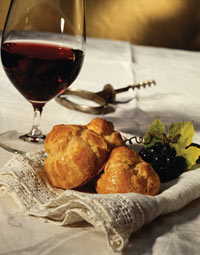
09 Dec A Perfect Match

Does the thought of selecting wines for your next party make you queasy? You are not alone. Many people find choosing wine a stressful task, but it doesn’t have to be. Think of wine as an ingredient in the recipe for a particular dish, not an independent course. It should taste as good when enjoyed with a dish as it does alone. The following guidelines will help focus your choices and create stress-free pairings.
- Match “like weights” Specifically, match the weight of the wine with the weight of the food— light fare with lighter-bodied, more delicate wines, and fuller-bodied wines with bigger foods. Most of us wouldn’t think to order a light, fruity Sauvignon Blanc with a filet mignon. Conversely, a glass of hearty Cabernet Sauvignon doesn’t go well with a delicate seafood salad. Think of a boxing match— would you put a heavyweight in the ring with a featherweight?
- Think of your pairing strategy— contrast or complement? We have all heard the sayings “opposites attract,” or the converse, “complementary partners make the best matches.” Sound like relationship advice? It is, but these rules also create successful food and wine pairings. Contrasting uses diverse flavors to enhance the differences; whereas complementary matches flavors to enhance the similarities. Think of a seafood dish in a creamy sauce. You could complement it with a rich, mellow white like Chardonnay or contrast it with a crisper white like Pinot Gris.
- Salt needs acid Acid in wine is that tangy or sour sensation felt on the tongue. That factor is found in crisp wines like Sauvignon Blanc, Riesling and Albarino, to name a few. Salty foods neutralize or soften acidity in a wine and need to be paired with higher-acid wines. Most meals should have at least moderate acidity. If the dish is particularly salty or briny, e.g., oysters, crabs, pickled items, etc—look for crisp or high-acid wines.
- Fats soften tannins Tannins are naturally astringent substances found in grape skins, and are perceived in our mouths as a sense of dryness. Reds with firmer tannins are a natural pairing with a fattier dish like red meat, cheese or stew. Try a Cabernet Sauvignon with a bite of steak and notice how the tannins soften in your wine. Bold reds pair nicely with heartier dishes—Cabernet Sauvignon, Cabernet Franc, Malbec or Syrah.
- Sweet with spicy For sweeter wines tone down spicy foods, whereas high-alcohol, dry wines intensify the heat of spices. If you are serving spicy cuisine, look for wines that are fruity and even a bit sweet to counteract. Whites that work with spicy food include lush whites like Riesling, Viognier, Gewurztraminer or Sauvignon Blanc. Reds that pair nicely with spicy dishes include fruity, lower tannin wines such as Beaujolais, Pinot Noir or Shiraz.

In the end, wine pairing is subject to personal taste. Chances are you and your guests may not agree on the best pairing for each course, but these rules can simplify selecting wines. So when entertaining you can concentrate on the most important pairing—enjoying time with your guests!
Want to learn more? Check out my new Weird Science DVD where I reveal the secrets of food and wine pairing…
This article appeared in the November issue of Baltimore Style magazine.
